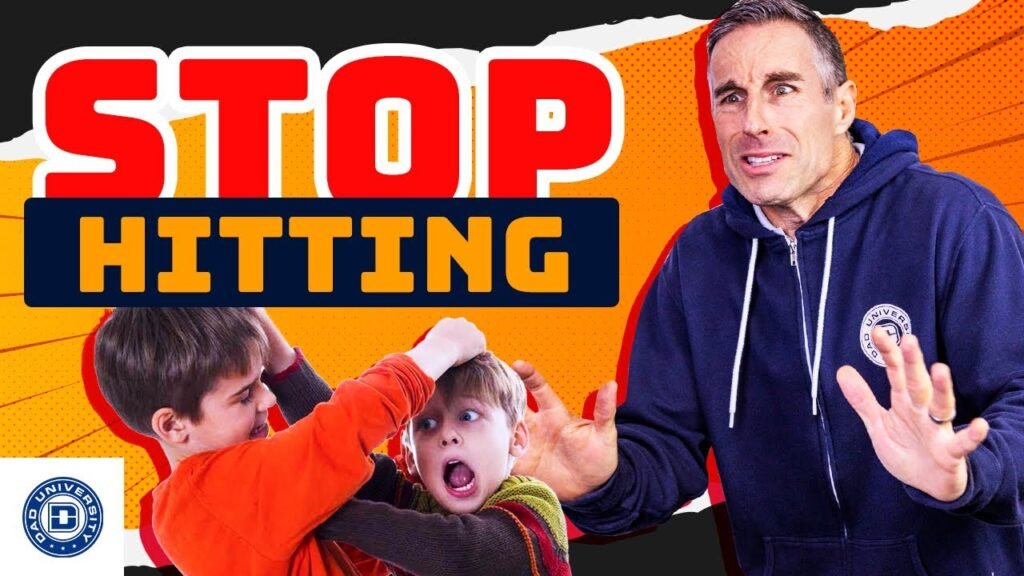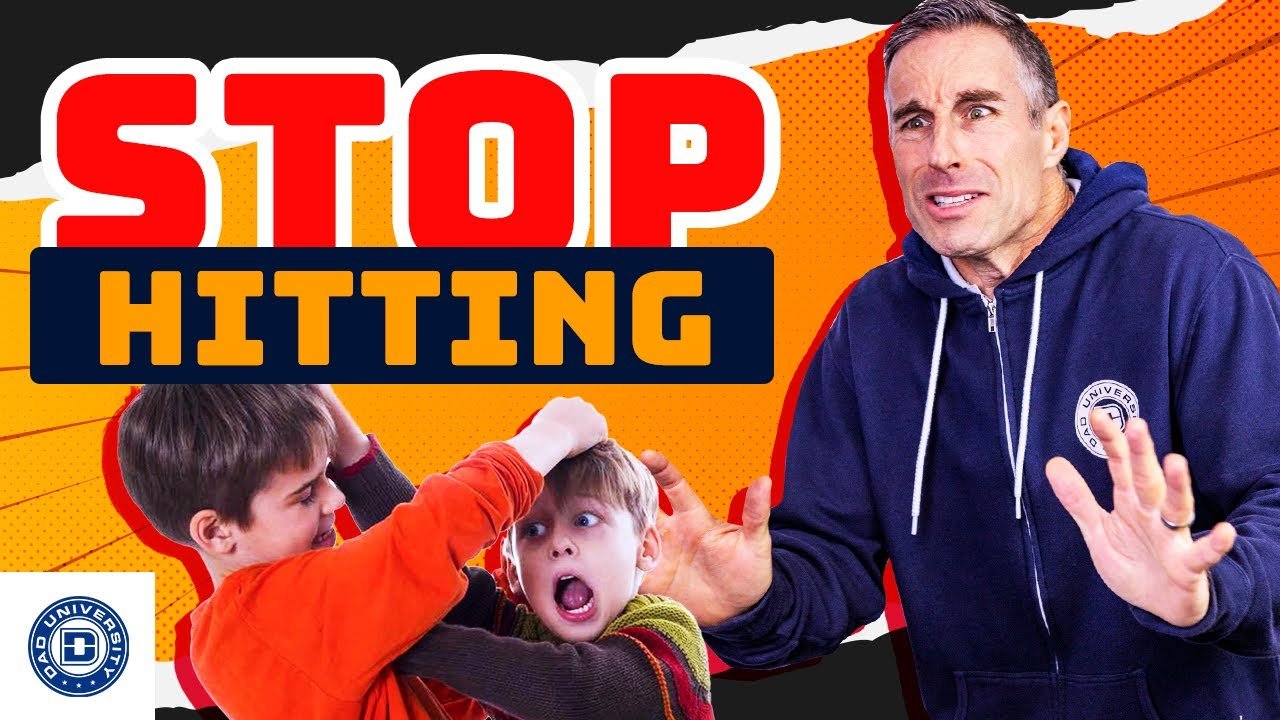In the video “Tips for Stopping Toddler Hitting Behavior,” Dad University provides valuable advice on how to address and prevent hitting behavior in toddlers. The video emphasizes the importance of staying calm and not reacting aggressively when your toddler hits. Punishing the child is not an effective solution; instead, focus on teaching them the correct behavior. The video also suggests having empathy towards your child’s perspective and intervening or removing the child from the situation when you see the hitting behavior coming. Additionally, the video discusses the significance of communicating that hitting hurts and introducing alternative behaviors such as being nice or gentle. It also touches on the importance of understanding your child’s triggers and avoiding those situations, as well as incorporating role playing and modeling appropriate behavior. Through practical tips and guidance, this video aims to help parents address and prevent toddler hitting behavior effectively.

Understanding Toddler Hitting Behavior
The commonality of hitting behavior among toddlers
Hitting behavior is a common occurrence among toddlers as they navigate the world around them. Toddlers are still learning how to deal with their emotions and handle different situations, and hitting can be a way for them to express their feelings or release tension. It is important to approach this behavior with understanding and empathy, recognizing that it is a normal part of their development.
The reasons behind toddler hitting behavior
There are various reasons why toddlers may engage in hitting behavior. They may hit as a means of communication when they cannot express themselves verbally. It could also be a result of frustration or an inability to handle a particular situation. Toddlers might hit when they feel threatened or overwhelmed, as hitting becomes their way of asserting control or defending themselves. By understanding the underlying causes of hitting behavior, parents and caregivers can better address the issue and help their toddlers find alternative ways to navigate their emotions and interactions with others.
Reacting to Toddler Hitting
Remaining calm and not reacting aggressively
When faced with your toddler hitting, it is crucial to remain calm and compose yourself. Reacting aggressively or punishing the child will not effectively address the behavior and may exacerbate the problem. Your toddler looks to you as a role model for appropriate behavior, so it is essential to model the calm and in-control response you want them to emulate.
Avoiding punishment as an effective solution
Punishment, such as spanking or yelling at your toddler, is not an effective solution for addressing hitting behavior. Instead, focus on teaching your child the correct behavior and providing them with alternatives to hitting. Punishment may instill fear and anxiety in your toddler, leading to further behavioral issues. By approaching the situation with understanding and patience, you can guide your child towards more appropriate ways of expressing themselves.
Teaching Alternative Behaviors
Empathy towards the child’s perspective
Empathy plays a crucial role in addressing your toddler’s hitting behavior. Put yourself in their shoes and try to understand their perspective. Toddlers may not have the vocabulary to express their emotions, and hitting may be their way of communicating their dissatisfaction or frustration. By acknowledging their feelings and showing empathy, you can create a safe and supportive environment for them to learn alternative ways of expressing themselves.
Physically intervening or removing the child from the situation
When you observe your toddler’s hitting behavior escalating, it may be necessary to physically intervene or remove them from the situation. By doing this, you can protect both your child and others from harm and provide them with a moment to calm down. Physical intervention should be done calmly and without aggression, ensuring that your response aligns with the behavior you want your child to adopt.
Communicating the Consequences of Hitting
Explaining that hitting hurts
It is important to communicate to your toddler that hitting hurts. They may not fully grasp the impact of their actions, so it is crucial to explain to them in simple terms that hitting can cause pain. You can gently say, “Hitting hurts. We don’t want to hurt others.” By doing so, you are helping them understand the consequences of their behavior and fostering empathy towards others.
Introducing alternative behaviors such as being nice or gentle
In addition to explaining the consequences of hitting, provide your toddler with alternative behaviors that are more appropriate. Encourage them to be nice or gentle instead of hitting. You can demonstrate these behaviors by using gentle touches or soft words, which will give your child a practical example to follow. Reinforce these alternative behaviors consistently and praise your child when they choose to be kind and gentle instead of hitting.
Preventing Toddler Hitting Incidents
Understanding and avoiding the child’s triggers
To effectively prevent hitting incidents, it is important to understand your child’s triggers. Observe the situations or circumstances in which your child is more likely to engage in hitting behavior. If you can identify these triggers, you can take proactive measures to avoid or address them. For example, if your toddler becomes frustrated when sharing toys, you can implement strategies to teach them the importance of sharing and provide them with alternative methods of expressing their frustration.
Creating a safe and peaceful environment
Creating a safe and peaceful environment is vital for preventing hitting incidents. Ensure that your toddler’s environment is free from potential triggers that may lead to hitting behavior. Provide ample opportunities for your child to engage in positive social interactions and play experiences. Encourage open communication and establish routines that promote a sense of security and stability for your toddler. By fostering an environment that prioritizes peaceful interactions, you can help your child develop healthy ways of expressing themselves.
Teaching Appropriate Behavior
Role playing and practicing appropriate behavior
Role-playing and practicing appropriate behavior can be effective methods for teaching your toddler how to handle different situations. You can use stuffed animals or dolls to act out scenarios that your child has encountered, such as sharing toys or resolving conflicts. By engaging in these pretend-play activities, your child can learn and practice the correct behaviors in a safe and controlled environment. Encourage them to express their emotions and guide them towards finding peaceful resolutions.
Providing examples and demonstrations
Providing examples and demonstrations of appropriate behavior can also aid in teaching your toddler how to respond in different situations. Be a role model for your child by showcasing kind and gentle actions. Narrate your actions as you interact with others, emphasizing the importance of using words instead of hitting. Showing your child how to handle conflicts and expressing emotions without resorting to hitting can have a significant impact on their behavior and understanding.
Modeling Desirable Behavior
Being a role model for your child
As a parent or caregiver, you have a profound influence on your child’s behavior. It is essential to be a positive role model by exhibiting the behavior you want your child to adopt. Practice patience, kindness, and empathy in your interactions with others, including your toddler. Children learn by observing and imitating, so consistently demonstrating desirable behavior will reinforce the message that hitting is not acceptable and that there are alternative ways to handle situations.
Ensuring consistency in your own behavior
Consistency is key when addressing hitting behavior. Ensure that your responses to hitting incidents are consistently calm, empathetic, and focused on teaching appropriate behavior. Avoid reacting aggressively or punishing your child, as this can confuse them and hinder their learning process. By remaining consistent in your approach, you create a stable and predictable environment for your child to learn and grow.
Seeking Professional Help
Identifying when professional help is needed
While hitting behavior is typically a normal part of a toddler’s development, there are instances where seeking professional help may be necessary. If your child’s hitting behavior is severe, frequent, or persists despite consistent interventions, it may be beneficial to consult with a pediatrician or child psychologist. These professionals can provide guidance, support, and specialized strategies for addressing the underlying causes of the hitting behavior.
Consulting with pediatricians or child psychologists
Pediatricians and child psychologists are well-equipped to support parents and caregivers in navigating and addressing hitting behavior in toddlers. They can assess your child’s overall development and provide valuable insights into the possible causes of the hitting behavior. Additionally, they can offer targeted interventions and strategies tailored to your child’s specific needs, ensuring a comprehensive approach to addressing the behavior.
Patience and Persistence
Understanding that changing behavior takes time
Changing behavior takes time, especially in toddlers who are still developing their emotional and social skills. It is crucial to approach the process with patience and understanding, recognizing that it may take repeated efforts and consistent reinforcement for your child to learn alternative behaviors. Keep in mind that progress may not be linear, and setbacks may occur. Stay committed to your child’s growth and development, and remember that change happens gradually.
Consistently reinforcing desired behavior
Consistency is vital when reinforcing desired behavior in your toddler. Praise and acknowledge your child when they choose alternative behaviors instead of hitting. Use positive reinforcement, such as verbal encouragement or small rewards, to reinforce the message that being kind and gentle is the preferred way to interact with others. Stay consistent in your expectations and reinforce the importance of using words instead of physical aggression.
Conclusion
Addressing toddler hitting behavior requires a combination of understanding, patience, and effective communication. By remaining calm, teaching alternative behaviors, and providing consistent reinforcement, parents and caregivers can help their toddlers navigate their emotions and interactions without resorting to hitting. Remember that it is a gradual process, and seeking professional help is always an option when needed. With empathy, persistence, and a supportive environment, you can guide your toddler towards healthier ways of expressing themselves and foster positive social interactions.

